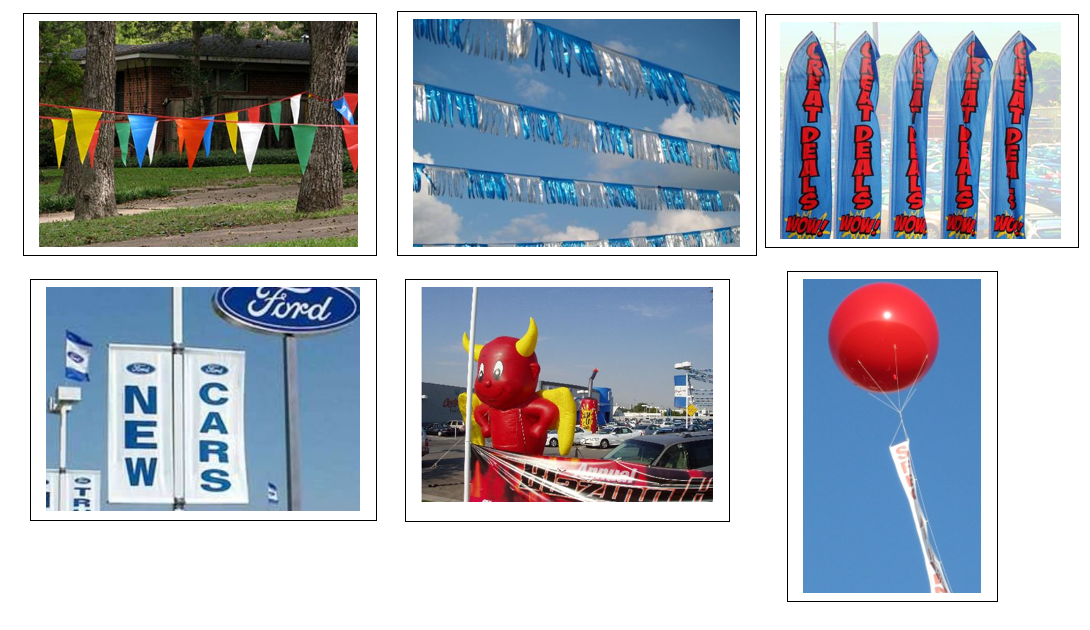Chapter 20.84
SIGN CODE
Sections:
Article I. General Provisions
20.84.020 Applicability and interpretations.
Article II. Permitting
20.84.080 Nonconforming signs, maintenance, removal and enforcement.
Article III. Sign Standards Applicable to All Signs
20.84.110 Sign placement and location restrictions.
20.84.120 Sign area measurements.
20.84.130 Sign height measurement.
20.84.140 Sign structure and installation.
Article IV. Sign Types
20.84.160 Awning or canopy signs.
20.84.170 Building-mounted wall signs.
20.84.180 Changeable copy signs.
20.84.200 Electronic message center (EMC) signs.
20.84.240 Service island signs.
Article V. Definitions, Chart of Sign Types
Article I. General Provisions
20.84.010 Intent and purpose.
A. Intent. Signs have a strong visual impact on the character and quality of the community. As a prominent part of the scenery, they attract or repel the viewing public, affect the safety of vehicular traffic, and their suitability or appropriateness helps to set the tone for the neighborhood. The city also relies upon its scenery and physical beauty to attract commerce, so aesthetic considerations assume economic value. It is the intent of the city, through this chapter, to protect and enhance the city’s historic and residential character and its economic base through the provision of appropriate and aesthetic signage. In addition, it is the intent of the city to limit the size, type and location of signs in order to minimize their distracting effect on drivers and thereby improve traffic safety.
B. Purpose. The purpose of this chapter is to promote the public health, safety and welfare through a comprehensive system of reasonable, effective, consistent, content-neutral and nondiscriminatory sign standards and requirements. This chapter has also been adopted to:
1. Promote and accomplish the goals, policies and objectives of the city’s comprehensive plan and zoning code;
2. To provide minimum standards in order to safeguard life, health, property and public welfare, and promote traffic safety by controlling the design, quality of materials, construction, illumination, size, location and maintenance of signs and sign structures;
3. Recognize free speech rights by regulating signs in a content-neutral manner;
4. Promote the free flow of traffic and protect pedestrians and motorists from injury and property damage caused by, or which may be fully or partially attributable to, cluttered, distracting and/or illegible signage;
5. Protect the beauty of the city’s built environment by encouraging signs that are compatible with the architectural style, characteristics and scale of the building to which they may be attached, and to encourage signs that are compatible with adjacent buildings and businesses;
6. Protect property values, the local economy, and the quality of life by preserving and enhancing the appearance of the streetscape;
7. Provide consistent sign design standards;
8. Protect and encourage creative and innovative approaches to signage, and signs that are of a quality design, pleasing in appearance and are appropriate in size, materials and illumination to the surrounding neighborhood;
9. Provide an improved visual environment for the citizens of and visitors to the city; and
10. Adopt clear, understandable regulations which enable the fair and consistent enforcement of this chapter. (Ord. 1965 § 2, 2017).
20.84.020 Applicability and interpretations.
A. This chapter applies to all signs as defined in PMC 20.84.290 (Definitions) within the city which are visible from any street, sidewalk or public place, regardless of the type or nature.
B. This chapter is not intended to, and shall not be interpreted to, restrict speech on the basis of its content, viewpoint, or message. Any classification of signs in this chapter which purports to permit speech by reason of the type of sign, identity of the sign user or otherwise shall be interpreted to allow commercial or noncommercial speech on the sign. No part of this chapter shall be construed to favor commercial speech over noncommercial speech. To the extent that any provision of this chapter is ambiguous, the term shall be interpreted not to regulate speech on the basis of the content of the message. (Ord. 1965 § 2, 2017).
20.84.030 Exemptions.
The following signs or activities relating to signs are exempt from the permitting requirements of this chapter:
A. Changes to the face or copy of changeable copy signs, digital signs, electronic messaging signs, provided such changes do not change the material or appearance of the sign as originally permitted by the city.
B. The normal repair and maintenance of conforming or legal nonconforming signs.
C. Temporary signs on private property or public property, meeting the requirements in PMC 20.84.260 (Temporary signs).
D. Building identification numbers as required pursuant to this code or any other city or state regulation.
E. Governmental Signs. Signs installed by the city, county, or a federal or state governmental agency for the protection of the public health, safety and general welfare, including, but not limited to, the following:
1. Emergency and warning signs necessary for public safety or civil defense;
2. Traffic and/or wayfinding signs erected and maintained by an authorized public agency;
3. Signs required to be displayed by law;
4. Signs showing the location of public facilities; and
5. Any sign, posting, notice, or similar sign placed by or required by a governmental agency in carrying out its responsibility to protect the public health, safety and general welfare.
F. Flags. Any flags; provided, that they conform to all provisions of this chapter for signs.
G. Certain Historic and Architectural Features. Stone or cement plaques and cornerstones with engraved or cast text or symbols and permanently embedded in the building’s foundation or masonry siding materials; provided, that none of these exceed four square feet in area.
H. Interior Signs. Signs or displays located entirely inside of a building and located at least three feet away from transparent doors and windows.
I. Nonvisible Signs. Signs not visible beyond the boundaries of the lot or parcel upon which they are located, or from any public right-of-way.
J. Vehicle with Signs. Any sign on a vehicle, unless such vehicle is parked or stationed near an activity for the primary purpose of attracting public attention to such activity, or unless such vehicle or mobile unit is regularly parked in any prominently visible location for the primary purpose of attracting public attention to the sign.
K. Temporary Signs in Windows. Any temporary sign taped or otherwise affixed to the inside of a window, in such a manner as to be easily removed; provided, that the total area of such sign in any one window does not exceed the square footage limitations in PMC 20.84.270 (Window signs) and 20.84.260 (Temporary signs).
L. Bench Signs. Any outdoor bench or furniture with any signs other than plaques one square foot or less in area.
M. Privately maintained traffic control signs in a subdivision with private roads or signs in a parking lot. (Ord. 1965 § 2, 2017).
20.84.040 Prohibited signs.
No person shall erect, alter, maintain or relocate any of the following signs in the city:
A. Animated Signs. A rotating or revolving sign, or signs where all or a portion of the sign moves in some manner. This includes any sign animated by any means, including fixed aerial displays, balloons, pennants, spinners, propellers, whirling, or similar devices designed to flutter, rotate or display other movement under the influence of the wind, including flag canopies not otherwise allowed in PMC 20.84.160 (Awning or canopy signs), streamers, tubes, or other devices affected by the movement of air or other atmospheric or mechanical means. This does not include historic signs and historic replica signs where the applicant is able to prove, through documentation or other evidence, that the original historic sign produced the same motion/movement and is proposed in the same location.
B. Rotating Signs. Any sign in which the sign body or any portion rotates, moves up and down, or any other type of action involving a change in position of the sign body or any portion of the sign, whether by mechanical or any other means.
C. Nuisance Signs. Any signs which emit smoke, visible particles, odors and sound, except that speakers in drive-through facilities shall be permitted.
D. Bench signs greater than one square foot in area.
E. Flashing Signs or Lights. A sign that contains an intermittent or flashing light source, or a sign that includes the illusion of intermittent or flashing light by means of animation, or an externally mounted intermittent light source. Flashing light sources are prohibited. Signs with an exposed light source, including clear light bulbs which do not flash, on a theater marquee, except for neon incorporated into the design of the sign, are also prohibited. Electronic message center signs and digital signs are allowed under the provisions of PMC 20.84.200 (Electronic message center (EMC) signs).
F. Hazardous Signs. Any sign that constitutes a traffic hazard or detriment to traffic safety by reason of its size, location, movement or method of illumination, or by obstructing the vision of drivers, or by distracting from the visibility of an official traffic control device by diverting or tending to divert the attention of drivers or moving vehicles from traffic movements on streets, roads, intersections or access facilities. No sign shall be erected so that it obstructs the vision of pedestrians or by glare or method of illumination constitutes a hazard to pedestrians or traffic. No sign may interfere with, mislead or confuse traffic.
G. No sign may impede free ingress and egress from any door, window or exitway required by building and fire regulations.
H. Permanent Signs on Vacant Lots, Parcels or Easements. No permanent sign shall be located on a vacant lot, parcel or easement. No permanent sign shall be located on a lot, parcel or easement as the principal use of that lot, parcel or easement. Signs may only be established as an accessory use to a principally permitted use.
I. Portable signs on wheels (trailer signs).
J. Abandoned signs.
K. Signs on utility poles, fences, on poles or trees.
L. Off-Site Controlled Signs. Any sign that is programmed and/or controlled off site.
M. Roof signs.
N. Festoons.
O. Signs which exceed the top of the roof or parapet on which they are attached.
P. Signs on vehicles, trailers, boats, or other similar property parked on private property, except as provided under PMC 20.84.110. (Ord. 1965 § 2, 2017).
Article II. Permitting
20.84.050 Sign permits.
A. Permit Required. No person shall erect, alter or relocate any sign requiring a permit under this chapter without first submitting a sign permit application and receiving approval of the sign permit from the city, unless the sign is identified as exempt under PMC 20.84.030 (Exemptions). Some sign types may be regulated under other codes adopted by the city, which may require additional permits that are subject to additional regulations, including, but not limited to, the building code (PMC Title 17) and right-of-way permits (Chapter 13.12 PMC). Signs for which permits are not required shall nonetheless comply with all applicable provisions of this chapter.
B. Review Procedures. The following steps shall be followed in the processing of sign permit applications:
1. Determination of complete application (PMC 16.20.040).
2. Notice of decision by community development manager (PMC 16.50.100).
3. Administrative appeal – open record hearing, to hearing examiner (Chapter 16.60 PMC).
C. Application Requirements. A complete sign permit application shall consist of the following:
1. Application Form. A completed sign permit application, including the applicant’s name, address, phone number, and e-mail address. If the applicant is not the property owner, then the property owner must be identified, and the application must include an affidavit from the property owner, verifying that the property owner has given permission to the applicant for the submission of the sign permit application and for the installation/posting of the sign on the property owner’s property.
2. Other Permit Applications. A completed building permit application, if required under the city’s building code; a completed right-of-way use permit application, if required under Chapter 13.12 PMC; a completed temporary use permit application, if required under Chapter 16.100 PMC.
3. Building Elevation/Site Plan. Signs proposed to be mounted on a building require a building elevation drawn to scale that specifies the location of the sign and drawings or photographs which show the scale of the sign in context with the building. Freestanding signs require a site plan indicating the proposed sign location as it relates to property lines, adjacent streets, and adjacent buildings.
4. Scaled Design Drawing. A colored rendering or scaled drawing including dimensions of all sign faces and descriptions of materials to be used, including color samples.
5. Scaled Installation Drawing. A scaled drawing that includes the sign description, proposed materials, size, weight, manner of construction and method of attachment, including all hardware necessary for proper sign installation.
6. Lighting. A drawing indicating the location and fixture type of all exterior lighting for the proposed signs. The drawing shall specify wattage and bulb type to ensure compatibility with the lighting standards in PMC 20.84.090 (Sign illumination).
7. Master Sign Plan. If the sign is subject to a master sign plan as described in PMC 20.84.060 (Master sign plans), a master sign plan must be included as part of a complete sign permit, unless a master sign plan for the site or building has already been approved and is on file with the city.
8. Fees. Payment of the appropriate sign permit fee.
D. Criteria for Approval. Sign permit applications shall be reviewed by the community development manager for consistency with the standards in this chapter, according to sign type and other applicable regulations. A sign permit shall not issue unless the manager makes findings that the criteria applicable to each sign type, as well as the general standards in this chapter, are satisfied. Building permit applications associated with signs shall be reviewed by the building official for consistency with the building code. If the sign uses electrical wiring and connections, a licensed electrician must submit a copy of the electrical permit application to the community development department, with the original submitted for approval to the state of Washington. If the sign requires a right-of-way use or temporary use permit, the application shall be submitted with the sign permit application for review by the public works or community development manager.
E. Notice of Final Decision. A notice of decision incorporating the decision on the sign permit application shall issue not more than 120 days after issuance of the determination of completeness. This deadline shall not apply if master sign plan approval, a right-of-way use permit or a special event permit is required.
F. Expiration of Sign Permit. Once the sign permit for the sign issues, the sign must be installed within 180 days or the sign permit will expire. Building permits and street right-of-way use permits shall expire in accordance with other applicable code provisions. No sign may be erected if the sign permit has expired, even if the associated building permit and/or street right-of-way use permit has not expired. (Ord. 1965 § 2, 2017).
20.84.060 Master sign plans.
A. Approval Required. Before the city will issue any sign permit relating to space in a proposed nonresidential, multitenant building(s), or multitenant site development, the city must first approve a master sign plan for the building(s). In addition, a master sign plan may be voluntarily developed and maintained by the owner or agent of any new or existing nonresidential use.
B. Review Procedures. The community development manager shall make the decision on the master sign plan without a hearing. The following steps shall be followed in the processing of a master sign plan:
1. Determination of complete application (PMC 16.20.040).
2. Notice of decision by manager (PMC 16.50.100).
3. Administrative appeal (if any) (open record hearing, hearing examiner).
C. Application Requirements. A complete master sign plan application shall consist of the following:
1. A complete master sign plan application, including the applicant’s name, address, phone number and e-mail address. If the applicant is not the property owner(s), then the property owner(s) must be identified and the application must include an affidavit from the property owner(s), verifying that the property owner(s) has given permission to the applicant for the submission of the master sign plan application. No sign may be placed upon real property without the consent of the real property owner(s);
2. A site plan drawn to legible scale, indicating the location of all buildings, driveways and pavement areas, landscape areas, abutting streets and proposed freestanding signs on the site;
3. Elevation drawings of each building on a site that indicate proposed sign locations on each of the buildings;
4. Maximum allowable signage on each elevation based upon a five percent calculation of all facades;
5. The master sign plan application shall identify the sign features and sign types proposed to be used on each building and the proposed location;
6. A narrative description of the development to demonstrate that the master sign plan meets the required design standards of this section; and
7. Fees. Payment of the appropriate fee for a master sign plan.
D. Criteria for Approval. All signs in the master sign plan must meet the criteria for approval in PMC 20.84.050 (Sign permits). In addition, all of the signs in the master sign plan:
1. Shall be architecturally similar and visually related to each other through the incorporation of common design elements. Up to two sign types may be used on any one building. All sign cabinets, trim caps and all sign supports such as poles and braces shall be of a common color;
2. Shall be architecturally integrated with the buildings included in the master sign plan; and
3. Must not obscure the view of other signs which are consistent with this chapter.
E. Notice of Final Decision. See PMC 20.84.050(E) (Sign permits).
F. Expiration of Master Sign Plan. Once a master sign plan is approved, the signs depicted in the approved plan must be installed within 180 days or the master sign plan will expire. Building permits and street right-of-way permits for any signs shown in the master sign plan shall expire in accordance with other applicable code provisions. No sign may be erected under an expired master sign plan, even if the associated sign permit, building permit or street right-of-way use permit has not expired.
G. Amendment to Master Sign Plan. An application for an amendment to an approved master sign plan may be made at any time, subject to the same limitations, requirements and procedures as those that apply to an original application in this section. Tenants whose signs are included in the amendment application need the property owner’s consent to file such application. In order to approve any such amendment, the manager shall consider the existing signs on the building(s) subject to the approved plan when determining whether the application meets the criteria for approval in subsection D of this section. (Ord. 1965 § 2, 2017).
20.84.070 Sign variances.
A. Approval Required. A variance may be granted from the strict application of the regulations in this chapter which apply to: (1) sign placement on a parcel or building frontage; (2) sign area; or (3) sign height, as regulated in this chapter. A variance may not be granted to allow any prohibited signs or prohibited sign features as described in PMC 20.84.040, or for any other purpose not listed in this subsection. The variance procedure in this section does not apply to any street right-of-way use permit or building permit.
B. Need for Sign Permit – Consolidation of Processing. A sign variance application may be submitted before or concurrent with the associated sign permit application. No sign permit application requiring a variance for issuance will be processed without a sign variance application unless the applicant specifically requests the application be processed without the variance.
C. Review Procedures. The following steps shall be followed in the processing of sign variance applications:
1. Determination of complete application (PMC 16.20.040).
2. Notice of decision by community development manager (PMC 16.50.100).
3. Administrative appeal, if any (open record hearing, hearing examiner).
D. Application Requirements. A complete sign variance application shall consist of the following:
1. Application Form. A completed sign variance application, including the applicant’s name, address, phone number and e-mail address. If the applicant is not the property owner, then the property owner must be identified and the application must include an affidavit from the property owner, verifying that the property owner has given permission to the applicant for the submission of the sign variance application and for the installation/posting of the sign on the property owner’s property.
2. Sign permit application (all of the materials required by PMC 20.84.050, Sign permits). However, the applicant may submit a variance application without a sign permit application as provided in subsection B of this section.
3. A narrative report which describes the requested variance in detail. The report shall identify all of the sections of this chapter from which the applicant is requesting the variance, as well as the nature and extent of the variance (in size, area, location on the property, height).
4. The narrative report shall also include the applicant’s description of the manner in which the sign variance satisfies all of the variance criteria in subsection E of this section.
5. Fees. Payment of the appropriate sign variance application fee.
E. Variance Criteria for Approval. Sign variance applications shall be reviewed by the community development manager to determine whether all of the following criteria are satisfied. In order to approve any sign variance, the manager must make written findings to show that all of the following criteria have been met:
1. The request for a sign variance is due to unusual conditions pertaining to sign visibility needs for a specific building or lot; and
2. The sign will not create a hazard; and
3. The sign will not violate any state statute or any city code provision (other than the ones identified in this chapter relating to signs); and
4. The sign will not negatively affect adjacent property; and
5. The sign will be in keeping with the general character of the surrounding area and the granting of the variance would not result in an alteration of the essential character of the surrounding area; and
6. The proposed variance is consistent with the purposes and intent of the zoning code and the purposes of this chapter; and
7. The variance is consistent with the city’s comprehensive plan; and
8. The applicant has established that there are practical difficulties in complying with the provision(s) of this chapter and that the proposed sign is a reasonable use of the property (economic considerations alone do not constitute practical difficulties); and
9. The plight of the applicant is due to circumstances unique to the property, which were not created by the applicant or landowner; and
10. The variance will not permit any sign or use that is not allowed in the zoning district where the affected land is located, nor will it allow any sign or sign feature prohibited under PMC 20.84.040.
F. First Amendment Exception/Variance. Where an applicant can demonstrate that the strict application of the regulations in this chapter would violate his/her First Amendment rights, the city may grant a variance that does not conform to all of the variance criteria in subsection E of this section. The applicant must still submit an application which conforms to this section. In order to approve such an exception/variance, the city need not make findings that all of the variance criteria in subsection E of this section have been satisfied, but if not all criteria have not been satisfied, the variance may only be granted to the extent reasonably necessary to protect the applicant’s First Amendment rights. If a First Amendment exception/variance is granted, it shall be treated as an approval of a variance for the purposes of this chapter.
G. Notice of Final Decision. A notice of decision incorporating the decision on the variance application shall issue not more than 120 days after issuance of the determination of complete application.
H. Expiration of Variance. If the variance is approved, the sign identified in the variance must be installed within 180 days or the variance will expire. No sign may be erected without a sign permit if the variance or the sign permit has expired, even if the applicant has received associated building permits or street right-of-way use permits, and the latter have not expired. (Ord. 1965 § 2, 2017).
20.84.080 Nonconforming signs, maintenance, removal and enforcement.
A. Nonconforming Signs. Any lawful nonconforming sign may be continued, as long as it is maintained only in the manner and to the extent that it existed at the time it became nonconforming. Illegal signs shall not be considered nonconforming signs. Nonconforming signs are subject to the provisions of (zoning code) Chapter 20.12 PMC (Nonconforming Uses and Structures).
B. Maintenance. It is unlawful for any owner of record, lessor, lessee, manager or other person having lawful possession or control over a building, structure or parcel of land to fail to maintain any signs on the building, structure or parcel in compliance with this chapter and the zoning code. Failure to maintain a sign constitutes a violation of this chapter, and shall be subject to enforcement under the provisions of code enforcement, Chapter 20.82 PMC.
1. Sign Maintenance. All signs, whether or not in existence prior to adoption of this chapter, shall be maintained. Maintenance of a sign shall include periodic cleaning, replacement of flickering, burned out or broken light bulbs or fixtures, repair or replacement of any faded, peeled, cracked or otherwise damaged or broken parts of a sign, and any other activity necessary to restore the sign so that it continues to comply with the requirements and contents of the sign permit issued for its installation and provisions of this chapter.
2. Landscape Maintenance. Required landscaped areas associated with an approved sign shall receive regular repair and maintenance. Plant materials that do not survive after installation in required landscape areas are required to be replaced within six months of the plant’s demise or within the next planting season, whichever event first occurs.
3. Removal. Any vacant and/or unused sign support structures, angle irons, sign poles or other remnants of old signs which are currently not in use, or are not proposed for immediate reuse by a sign permit application for a permitted sign, shall be removed. In addition to the remedies in code enforcement, Chapter 20.82 PMC, the manager shall have the authority to require the repair, maintenance or removal of any sign or sign structure which has become dilapidated or represents a hazard to the safety, health or welfare of the public, at the cost of the sign and/or property owner.
4. Enforcement. Violations of the provisions of this chapter shall be enforced according to code enforcement, Chapter 20.82 PMC. (Ord. 1965 § 2, 2017).
Article III. Sign Standards Applicable to All Signs
20.84.090 Sign illumination.
A. General. No temporary sign may be illuminated. No sign located in a residential zone may be illuminated, except that on parcels two acres in size or greater, signs may be halo illuminated or illuminated as necessary for allowable digital signs. Permanent signs allowed by this chapter may be nonilluminated, or illuminated by internal light fixtures, halo illuminated, or have external indirect illumination, unless otherwise specified. All illuminated signs shall comply with the time limitations of subsection D of this section.
B. Externally Illuminated Signs.
1. Except as provided in this subsection, externally illuminated signs shall be illuminated only with steady, stationary, fully shielded light sources directed solely onto the sign without causing glare. Light shielding shall ensure that the lamp or light source is not visible beyond the premises and shall further ensure that the light is contained within the sign face.
2. A light fixture mounted above the sign face may be installed with its bottom opening tilted toward the sign face, provided:
a. The bottom opening of the light fixture is flat (i.e., it could be covered by a flat board allowing no light to escape); and
b. The uppermost portion of the fixture’s opening is located no higher than the top of the sign face, as shown in Figure 20.84.090A below. Light fixtures aimed and installed in this fashion shall be considered fully shielded.
Figure 20.84.090A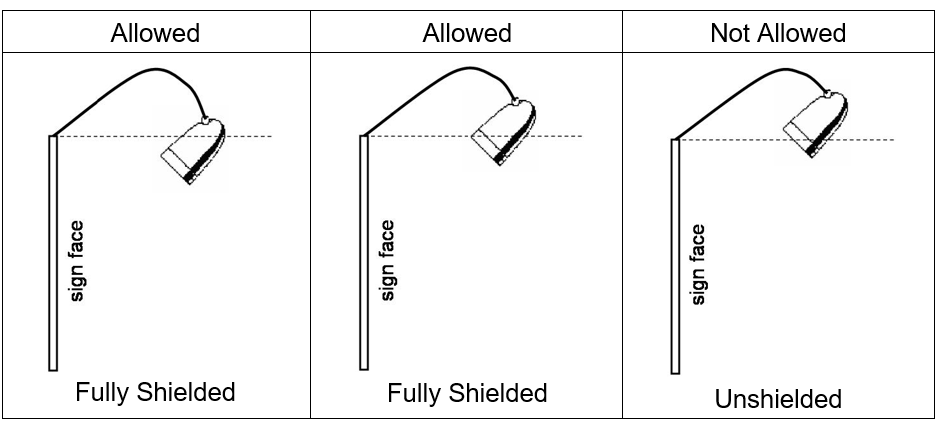
C. Internally Illuminated Signs.
1. Internally illuminated signs shall be constructed with an opaque background and translucent text and symbols. If the sign owner desires to have the entire sign face visible at night, an external light source may be used to illuminate the sign, subject to the illumination standards in this chapter.
2. No digital, neon (Figure 20.84.090C), or electronic message center sign shall exceed a brightness level of 0.3 foot-candle above ambient light as measured using a foot-candle (lux) meter at a preset distance provided in Table 20.84.090B in accordance with the following procedure:
a. At least 30 minutes past sunset, record the ambient light while the sign is off or displaying all black copy, or with the sign’s illumination blocked.
b. The light meter shall be held five feet above the finished grade in front of the sign.
c. The meter shall be aimed toward the center of the electronic message center sign.
From the same location, a second reading shall be recorded while the sign is on and not blocked.
3. If the difference between the measurements is 0.3 foot-candle or less, the brightness is properly adjusted; otherwise, the EMC must be adjusted to comply with the brightness adjustment standard set forth above.
|
Area of electronic message center in square feet |
Measurement distance in linear feet |
|---|---|
|
10 |
32 |
|
20 |
45 |
|
30 |
55 |
Figure 20.84.090C
Neon Sign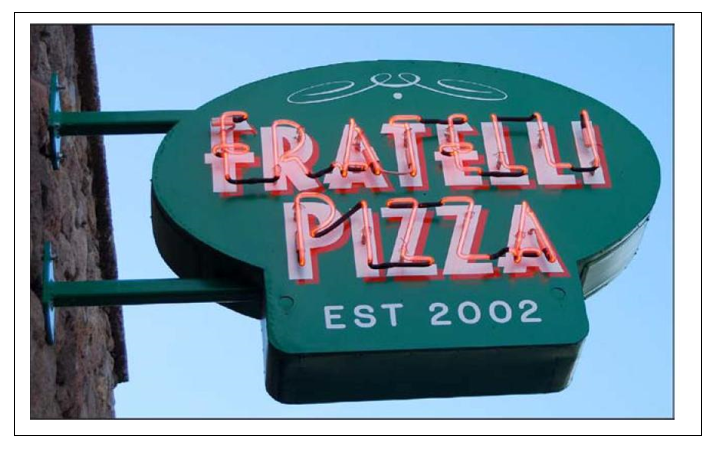
D. Time Limitations. All signs over three square feet in area shall be turned off by 11:00 p.m., or when the business closes, whichever is later. Signs subject to time limitations are required to have functioning and properly adjusted automatic shut-off timers. (Ord. 1965 § 2, 2017).
20.84.100 Sign materials.
A. Temporary Signs. The construction of temporary signs is limited to the materials described in the definition of “temporary sign” (PMC 20.84.290, Definitions). In addition, the temporary sign must also conform to the requirements of this chapter, including, but not limited to, PMC 20.84.260 (Temporary signs).
B. Permanent Signs. Permanent signs must be manufactured of durable materials that withstand the effects of water and wind. The following additional requirements apply to any permanent signs larger than 30 square feet, except for window signs located inside glass:
1. Paper-faced signs, including vinyl-coated paper and those applied with adhesives, are not allowed. Canvas or vinyl signs must be made of minimum 20-ounce materials with polymeric plasticizers for durability.
2. Sign faces made of canvas, fabric, vinyl or similar pliable materials that are attached to permanent sign structures must be mounted behind a perimeter frame or trim cap so that the edges of the sign face are not exposed, except that flags made of 100 percent spun polyester are exempt from this requirement.
Sign Structure Materials(2).152122.png)
Sign Structure Which Blends with Development Site(2)-2.152122.png)
(Ord. 1965 § 2, 2017).
20.84.110 Sign placement and location restrictions.
A. City Right-of-Way. No sign may be placed within the city right-of-way (see PMC 20.84.260(E) for restrictions on temporary signs outside of the roadway) except as otherwise permitted with a city right-of-way use or special event permit.
B. Attached to Vehicles on Private Premises. No sign may be mounted, attached or painted on a trailer, boat or motor vehicle, which is parked, stored or displayed conspicuously on private premises in a manner intended to attract the attention of the public. (This excludes signs that are permanently painted or wrapped on the surface of the vehicle, or adhesive vinyl film affixed to the interior or exterior surface of a vehicle window, or signs magnetically attached to motor vehicles or rolling stock that are actively used in the daily conduct of business. However, such vehicles shall be operable and parked in a lawful or authorized manner.)
Figure 20.84.110A
Signs on Vehicles Used for Business Purposes
C. Attached to Other Fixtures. No sign may be painted, attached or mounted on fuel tanks, storage containers and/or solid waste receptacles or their enclosures, except for information required by law. (Ord. 1965 § 2, 2017).
20.84.120 Sign area measurements.
Sign area for all sign types is measured as follows:
A. Background Panel or Surface. Sign copy mounted, affixed or painted on a background panel or surface distinctively painted, textured or constructed as a background for the sign copy is measured as that area contained within the smallest rectangle, parallelogram, triangle, or circle that will enclose the sign copy and the background, as shown in Figures 20.84.120A, 20.84.120B, 20.84.120C and 20.84.120D.
Figure 20.84.120A
Sign Area for Signs on Background Panel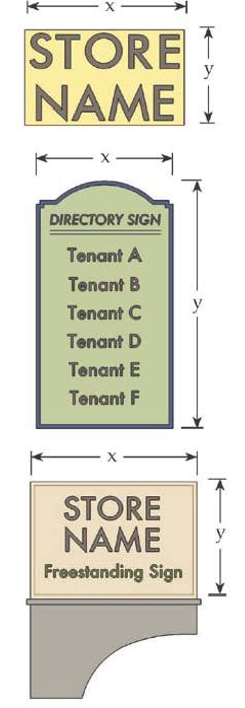
B. Individual Letters or Graphics. Sign copy mounted as individual letters or graphics against a wall, fascia, mansard or parapet of a building or surface of another structure that has not been painted, textured or otherwise altered to provide a distinctive background for the sign copy is measured as the sum of the smallest square, rectangle, parallelogram, triangle or circle that will enclose each word, name, sentence and complete message, and each graphic in the sign.
C. Illuminated Surface. Sign copy mounted, affixed or painted on an illuminated surface or illuminated element of a building or structure is measured as the entire illuminated surface or illuminated element which contains sign copy, as shown in Figure 20.84.120B. Such elements may include, but are not limited to, lit canopy fascia signs and/or interior lit awnings.
Figure 20.84.120B
Sign Area for Signs with Illuminated Surfaces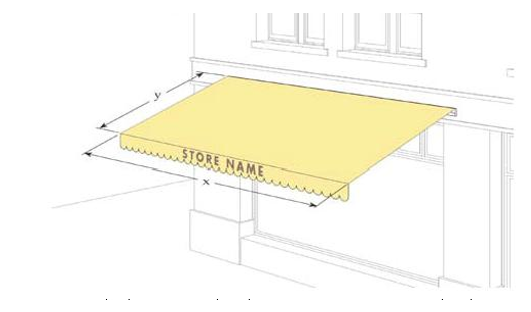
D. Backlit Translucent Panels. Backlit translucent panels and spandrels, with or without text or graphics, are measured as the area of the height and width of any internally illuminated translucent panel, including the side panels if the structure or spandrel is greater than six inches in width.
E. Multiface Signs. Multiface signs, as shown in Figure 20.84.120C, are measured as follows:
1. Two-Face Signs. If the interior angle between the two sign faces is 45 degrees or less, the sign area is of one sign face only. If the angle between the two sign faces is greater than 45 degrees, the sign area is the sum of the areas of the two sign faces.
2. Three- or Four-Face Signs. The sign area is 50 percent of the sum of the areas of all sign faces.
3. Spherical, free-form, sculptural or other non-planar sign area is measured as 50 percent of the sum of the areas using only the four vertical sides of the smallest four-sided polyhedron that will encompass the sign structure, as shown in Figure 20.84.120C. Signs with greater than four polyhedron faces are prohibited.
Figure 20.84.120C
Sign Area for Multiface Signs or Free Form Signs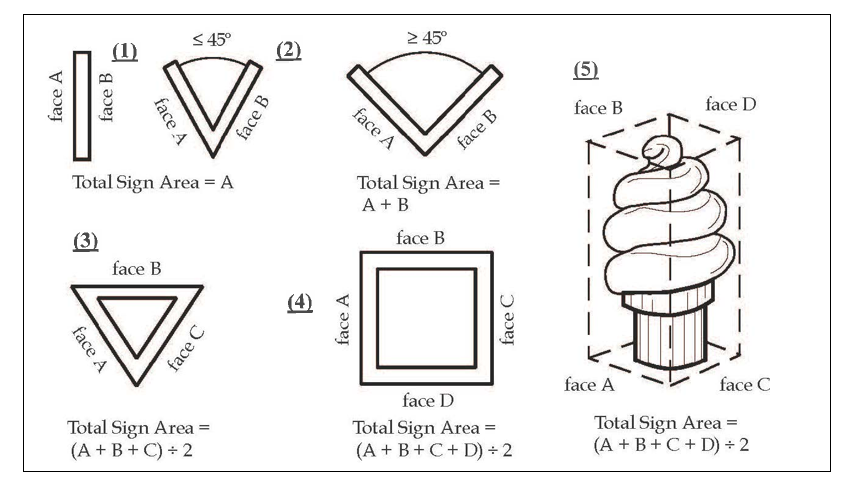
F. Odd Shaped Signs. The area of an odd shaped sign having no continuous border shall mean the entire area within a single continuous perimeter formed by no more than eight straight lines enclosing the extreme limits of writing, representations, emblem, or any figure or similar character, together with any frame or other material or color forming an integral part of the display or used as a border excluding the necessary supports or uprights on which such sign is placed (see Figure 20.84.120D).
Figure 20.84.120D
Sign Surface Area, Odd Shaped Sign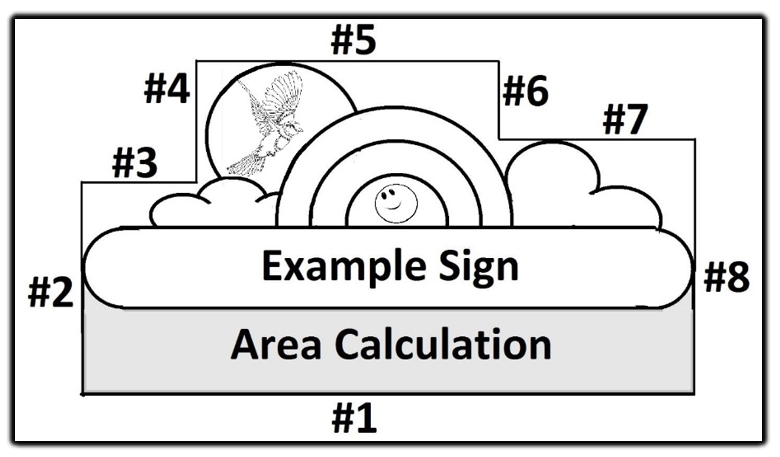
(Ord. 1965 § 2, 2017).
20.84.130 Sign height measurement.
Sign height is measured as follows:
A. Freestanding Signs. Sign height is measured as the vertical distance from natural grade at the base of a sign to the top of the sign, including the sign support structure, except that signs within 25 feet of an adjacent road may be measured as follows:
1. If natural grade at the base of a sign is higher than the grade of the adjacent road, sign height shall be measured from the base of the sign as shown in Figure 20.84.130A.
Figure 20.84.130A
Freestanding Sign Height – Signs Higher than the Grade of an Adjacent Road
2. If natural grade at the base of the sign is lower than the grade of an adjacent road, the height of the sign shall be measured from the top of curb or road-grade elevation; provided, that fill is placed between the curb and the sign and extends at least five feet beyond the base of the sign in all directions, as shown in Figure 20.84.130B.
Figure 20.84.130B
Freestanding Sign Height – Sign Lower than the Grade of an Adjacent Road
(Ord. 1965 § 2, 2017).
20.84.140 Sign structure and installation.
A. Support Elements. Any angle iron, bracing, guy wires or similar features used to support a sign shall not be visible.
B. Electrical Service. When electrical service is provided to freestanding signs or landscape wall signs, all such electrical service is required to be underground and concealed. Electrical service to building-mounted wall signs, including conduit, housings and wire, shall be concealed or, when necessary, painted to match the surface of the structure upon which they are mounted. A building permit (electrical) must be issued prior to the installation of any new signs requiring electrical service.
C. Raceway Cabinets. Raceway cabinets, where used as an element of building-mounted wall signs, shall match the building color at the location of the building where the sign is located. Where a raceway cabinet provides a contrast background to sign copy, the colored area is considered part of the sign face and is counted in the aggregate sign area permitted for the site or business. Examples of raceway cabinets are shown in Figure 20.84.140A.
Figure 20.84.140A
Raceway Cabinets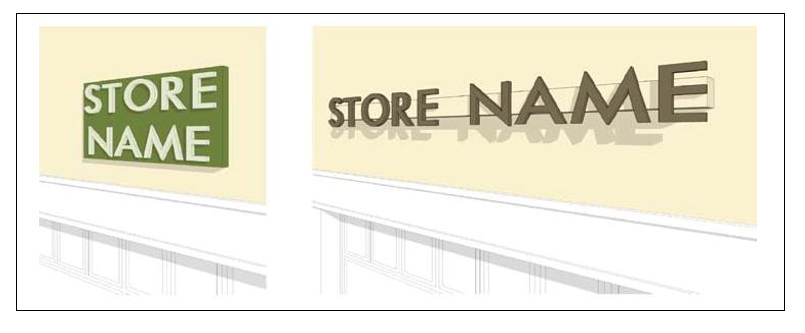
D. Limitation on Attachments and Secondary Uses. All permitted sign structures and their associated landscape areas shall be kept free of supplemental attachments or secondary uses including, but not limited to, supplemental signs not part of a permitted sign, light fixture, newspaper distribution racks or trash container. The use of sign structures and associated landscape areas as bicycle racks or support structures for outdoor signs is prohibited. (Ord. 1965 § 2, 2017).
Article IV. Sign Types
20.84.150 Accessory signs.
No permit shall issue for an accessory sign which does not comply with the following standards:
A. Number. A maximum of one sign at each vehicle point of entry or egress, not to exceed four accessory signs per parcel.
B. Location. Flexible; provided, that the number of signs in subsection A of this section is not exceeded; and provided, that the signs comply with the setback standards for freestanding signs in PMC 20.84.210.
C. Zones. Not allowed in residential zones, except on sites two acres or larger.
D. Design. Nonilluminated or internal illumination only. Any accessory sign with electronic display must conform to all EMC and/or digital sign standards in PMC 20.84.190 (Digital signs) or 20.84.200 (Electronic message center (EMC) signs).
E. Size. Maximum sign area: three square feet per face; may be double-sided.
F. Height. Mounting height:
1. Building-mounted wall sign (PMC 20.84.170): maximum of eight feet; must be flat against a wall of the building.
2. Freestanding sign (PMC 20.84.210): maximum of three feet from grade.
Figure 20.84.150A
Accessory Signs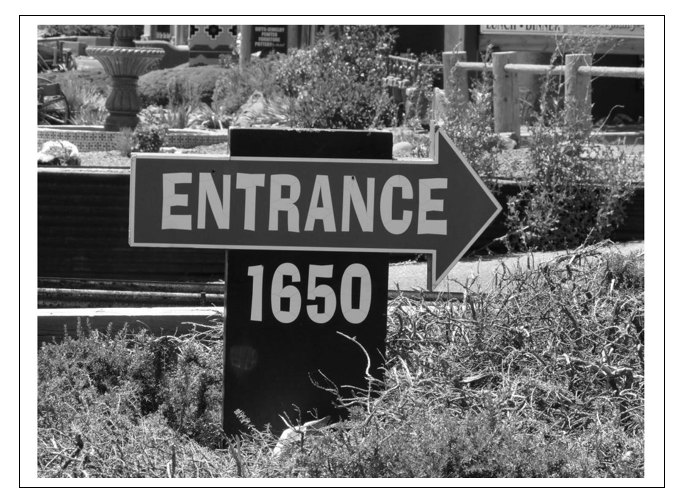
G. Drive-Through Large Accessory Signs. In addition to the accessory signs allowed for vehicle points of entry and in addition to free-standing signs otherwise allowed under PMC 20.84.210, large accessory signs are allowed for each point of entry to a drive-up window, subject to the following standards:
1. Maximum sign area per drive-up point of entry: 45 square feet.
2. Maximum sign size: 50 square feet.
3. Maximum sign height: five feet, six inches, including the associated sign structure.
4. Orientation. Large accessory signs must be oriented so that the sign face is not visible from the view of the street or public right-of-way.
5. Screening. All sides of large accessory signs must be screened from the view of the street or public right-of-way with landscaping or walls of brick, stone or siding materials that match the principal walls of the building to which the sign applies. If landscaping is used for screening, it must provide full screening at maturity and must be large enough at planting to provide at least 70 percent screening of the sign.
6. Audio. No sound or amplification may be emitted that is audible beyond the site. (Ord. 1965 § 2, 2017).
20.84.160 Awning or canopy signs.
No permit shall issue for an awning or canopy sign which does not comply with the following standards:
A. Number. One awning or canopy sign is allowed for each primary entrance to a building or tenant space. In addition, one awning or canopy sign may be allowed on a secondary entrance which faces a public street or on-site parking area. (As used in this subsection, “street” shall include freeways, but exclude alleys and serviceways.) The awning/canopy sign may only be placed on the ground floor level facade of the building.
B. Area. The sign area on the primary elevation shall not exceed one square foot of sign area per lineal foot of awning or canopy width. A maximum of 40 percent of an awning or canopy on which signage is proposed may be of an angle greater than 60 degrees from horizontal.
Figure 20.84.160A
Awning/Canopy Sign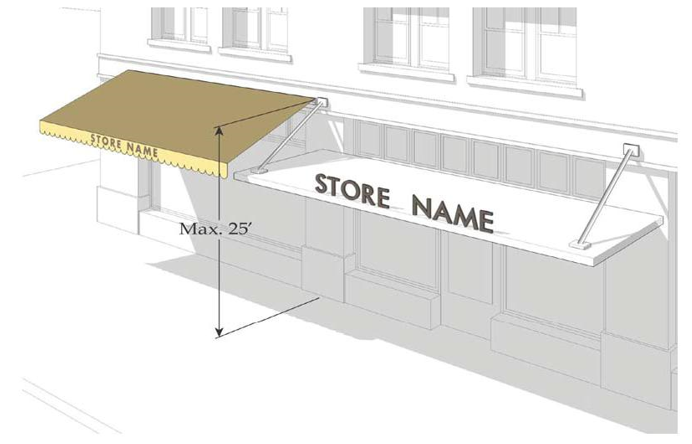
C. Location.
1. An awning/canopy sign may not be mounted higher than a maximum of 25 feet above the ground floor.
2. An awning/canopy sign shall not project above, below or beyond the edges of the face of the building wall or architectural element on which it is located.
3. No part of the sign, as a part of or displayed on the vertical surface of an awning/canopy, shall project beyond the edges of the awning/canopy surface on which it is displayed. If an awning/canopy is placed on multiple store fronts, each business or tenant space is permitted signage no greater than 60 percent of the store width or tenant space.
4. The awning/canopy shall not extend horizontally a distance greater than 60 percent of the width of the awning/canopy or valance on which it is displayed.
D. Zone. Not allowed in residential zones.
E. Design. If sign letters or logos are placed on an awning/canopy, only the face area containing the letters or logos may be illuminated. All illumination must be internal behind the surface of the awning/canopy. The sign may also be nonilluminated. (Ord. 1965 § 2, 2017).
20.84.170 Building-mounted wall signs.
No permit shall issue for a building-mounted wall sign which does not comply with the following standards:
A. Residential Zones. The maximum building-mounted wall signage allowed in residential zones is as follows:
1. Size of Parcel or Site. Wall signs are not allowed on sites smaller than two acres, except for address numbers as required by law.
2. Area. One hundred square feet total, not to exceed three percent of the area of the facade upon which the sign is placed. Width: Not to exceed 60 percent of the width of the wall plane upon which the sign is placed.
3. Design. Nonilluminated.
B. Nonresidential Zones.
1. Size of Parcel or Site. No restrictions.
Figure 20.84.170A
Standards for Building Mounted Signs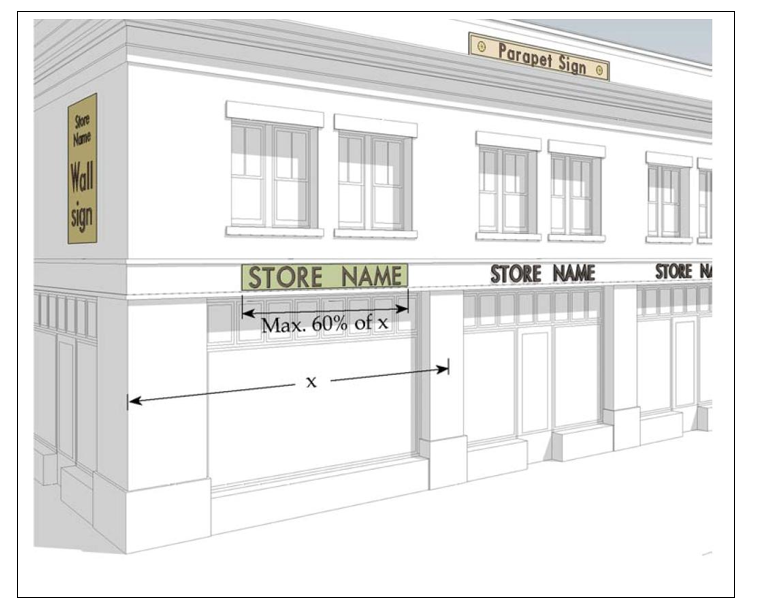
2. Area. The total signage may be up to 10 percent of the area of the facade or 25 square feet, whichever is greater, up to a maximum of 100 square feet. Width: Not to exceed 60 percent of the width of the wall plane upon which the sign is placed or the width of the tenant space. Height: Not to exceed 85 percent of the height of the blank wall space or fascia on which the sign is mounted (see Figure 20.84.170A).
3. Location on Building. Signs may not cover or obscure important architectural details of a building, such as stair railings, windows, doors, decorative louvers or similar elements intended to be decorative features of a building design. Signs must appear to be a secondary feature of the building facade.
4. Illumination, Flush- or Tight-Mounted. All individual letter signs shall be installed to appear flush-mounted. If the letters are illuminated and require a raceway, the letters shall be installed tight against the raceway, which shall be painted to match the color of the surface to which the raceway is mounted. Where possible, especially on new construction, the raceway should be recessed to allow letters to be flush with the wall surface.
5. Design. Where more than one sign is allowed for a business, all signs shall be consistent in design, style, color and method of illumination. Where there are multiple businesses or tenants on a site, all signs shall conform to a master sign plan consistent with PMC 20.84.060.
6. Signs Facing Residential Zones. Signs facing residential zones shall have dark backgrounds with light lettering. (Ord. 1980 § 9, 2018; Ord. 1965 § 2, 2017).
20.84.180 Changeable copy signs.
No permit shall issue for a changeable copy sign which does not comply with the following standards:
A. Number. No more than one changeable copy sign shall be allowed for each parcel, except that additional changeable copy signs are permitted as follows:
1. The additional changeable copy sign(s) must be placed at least 100 feet from abutting streets or rights-of-way; and
2. The additional changeable copy sign(s) must not exceed the maximum area, height, and quantity standards otherwise applicable to any freestanding or building-mounted wall signs on the parcel.
B. Area. No more than 20 percent of the allowed wall sign area or 50 percent of a freestanding sign face may be changeable copy (this does not apply to signs required by law). Wall-mounted changeable copy signs placed at least 100 feet from abutting streets may be a maximum of 50 percent of permitted wall sign area.
Figure 20.84.180A
Changeable Copy Sign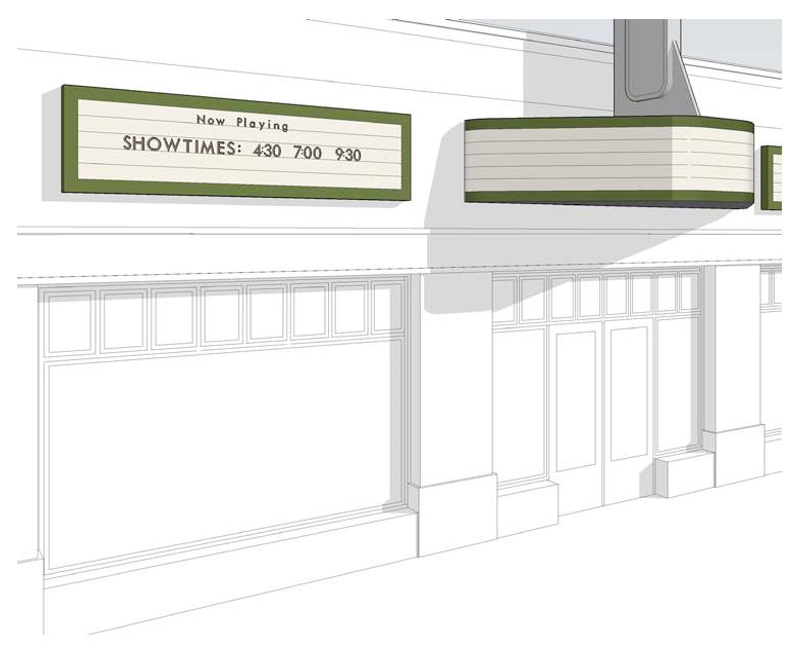
C. Height above Grade. Fifteen feet maximum. For wall signs, limited to the maximum height for freestanding signs.
D. Placement/Location. Allowed only as an integral part of a building-mounted sign or a freestanding sign.
E. Zones. Changeable copy signs are allowed in all zones.
F. Design. Nonilluminated in all zones. Internally or indirectly illuminated in nonresidential zones applicable to the illumination standards in PMC 20.84.090. (Ord. 1965 § 2, 2017).
20.84.190 Digital signs.
Digital signs are not separately allowed signs. No permit shall be issued for a digital sign which does not comply with the following standards:
A. Maximum size: 30 square feet. The area of a digital sign shall be counted as part of the allowable sign area for a freestanding or building sign. The digital sign shall be incorporated as an integral component in either a permitted freestanding or building-mounted sign.
B. Density: one digital sign per 100 feet of street frontage in nonresidential zones. One digital sign per 200 feet of street frontage in residential zones, not to exceed one sign per parcel.
C. Zoning: allowed in residential and nonresidential zones only.
D. Maximum brightness: see PMC 20.84.090.
E. Motion limits: no motion except for instantaneous change of message.
F. Minimum hold between messages: eight seconds.
G. Programming. To ensure that digital signs are programmed and continue to operate according to local standards, digital signs shall be designed for local on-site control and programming. (Ord. 1965 § 2, 2017).
20.84.200 Electronic message center (EMC) signs.
Electronic message center (EMC) signs are not separately allowed signs. No permit shall be issued for an EMC which does not comply with the following standards:
A. Maximum size: 30 square feet. The area of an electronic message center sign shall be counted as part of the allowable sign area for a freestanding or building sign. The EMC shall be incorporated as an integral component in either a permitted freestanding or building-mounted sign.
B. Density: one EMC per 100 feet of street frontage, not to exceed one per business and tenant space. Electronic message center signs shall not be a sign separate from a freestanding or building sign.
C. Zoning: prohibited in residential zones.
D. Minimum parcel per sign: one acre.
E. Maximum Brightness. See PMC 20.84.090.
F. Motion Limits. No motion except for a fade in of the next message with the fade transition being no more nor less than 1.5 seconds. Fade transition is required rather than instantaneous message changes to avoid sudden or startling flashes of light.
G. Minimum hold between messages: 10 seconds, plus 1.5-second transition fade.
H. Programming. To ensure that EMCs are programmed and continue to operate according to local standards, EMCs shall be designed for local on-site control and programming. The applicant shall provide a written certificate from the sign manufacturer that the nighttime light intensity has been factory preset not to exceed allowable levels under this section, and that this setting is protected from end-user modification by password-protected software or other method that ensures compliance. (Ord. 1965 § 2, 2017).
20.84.210 Freestanding signs.
No sign permit shall issue for a freestanding sign which does not comply with the following standards:
A. Number.
1. The number and type of freestanding signs for single- and multiple-tenant uses are derived from the use, zone, location and length of development site frontage as described in this section.
2. One freestanding sign is allowed for each site frontage on a public right-of-way improved for vehicles up to a maximum of two signs. Flag lot sites with frontage on a public street are permitted one sign on the frontage providing primary access to the site.
3. Where more than one freestanding sign is proposed on a site with multiple frontages on a public right-of-way improved for vehicles, a minimum of 100 feet as measured in a straight line shall separate each sign.
4. The permanent sign base shall have a minimum aggregate width of 40 percent of the width of the sign cabinet or face.
(4).152122.png)
B. Location.
1. No freestanding sign shall be permitted on any site that does not have street frontage.
2. Freestanding signs shall be set back from side and front property lines as provided in Table 20.84.210A.
|
|
RO, RS, RML |
RMH |
NB |
MC, C |
OP |
LI |
HC |
HI |
|---|---|---|---|---|---|---|---|---|
|
Sign Setback – Front Property Line, Interior Lot |
5 ft. |
5 ft. |
5 ft. |
5 ft. |
5 ft. |
5 ft. |
5 ft. |
5 ft. |
|
Sign Setback – Side Property Line, Interior Lot |
10 ft. |
10 ft. |
10 ft. |
10 ft. |
10 ft. |
10 ft. |
10 ft. |
10 ft. |
|
Sign Setback – Corner Lots |
5 ft. from all property lines |
5 ft. from all property lines |
5 ft. from all property lines |
5 ft. from all property lines |
5 ft. from all property lines |
5 ft. from all property lines |
5 ft. from all property lines |
5 ft. from all property lines |
3. No freestanding sign shall be located in the triangular area(s) measured 15 feet by 15 feet where a driveway enters onto a street, or in any other area which may obstruct the vision of motorists so as to create a safety hazard. Additionally, all signs are subject to the public works standards regarding sight distances.
Freestanding Sign(3).152122.png)
C. Height and Area. The height and area of a freestanding sign shall be governed by the maximum height and area requirements provided in Tables 20.84.210B and 20.84.210C.
|
|
RO, RS, RML |
RMH |
NB |
MC, C |
OP |
LI |
HC |
HI |
|---|---|---|---|---|---|---|---|---|
|
Maximum Height of Freestanding Signs |
5 ft.
For non-residential and multi-family uses only |
5 ft.
For non-residential and multi-family uses only |
5 ft. |
15 ft.
20 ft. for multiple occupancy or building complexes |
10 ft.
15 ft. for multiple occupancy or building complexes |
15 ft.
20 ft. for multiple occupancy or building complexes |
15 ft.
20 ft. for multiple occupancy or building complexes |
15 ft.
20 ft. for multiple occupancy or building complexes |
|
|
RO, RS, RML |
RMH |
NB |
MC, C |
OP |
LI |
HC |
HI |
|---|---|---|---|---|---|---|---|---|
|
Maximum Sign Area of Freestanding Signs per Face |
15 sq. ft. per face
For non-residential and multi-family uses only |
15 sq. ft. per face
For non-residential and multi-family uses only |
15 sq. ft. per face |
85 sq. ft. per face
150 sq. ft. per face fronting only on SR 167
100 sq. ft. per face for multiple occupancy or building complexes |
40 sq. ft. per face
48 sq. ft. per face for multiple occupancy or building complexes |
85 sq. ft. per face
150 sq. ft. per face fronting only on SR 167
100 sq. ft. per face for multiple occupancy or building complexes |
85 sq. ft. per face
150 sq. ft. per face fronting only on SR 167
100 sq. ft. per face for multiple occupancy or building complexes |
85 sq. ft. per face
100 sq. ft. per face for multiple occupancy or building complexes |
SR = State Route
D. Signs Facing Residential Zones. Signs facing residential zones shall have dark backgrounds with light lettering. (Ord. 1965 § 2, 2017).
20.84.220 Portable signs.
No permit shall be issued for a portable sign (includes sandwich board and pole-mounted signs) which does not comply with the following standards:
A. Zone. Allowed only in nonresidential zones, except that temporary portable signs are allowed in residential zones, subject to the provisions of PMC 20.84.260 (Temporary signs).
B. Design and Materials. Must be designed with durable materials; otherwise they will be regulated as temporary signs under PMC 20.84.260. Portable signs must be designed to withstand wind and include a heavy weighted base for pole-mounted signs, and a heavy weight suspended between the opposing faces of a sandwich board sign.
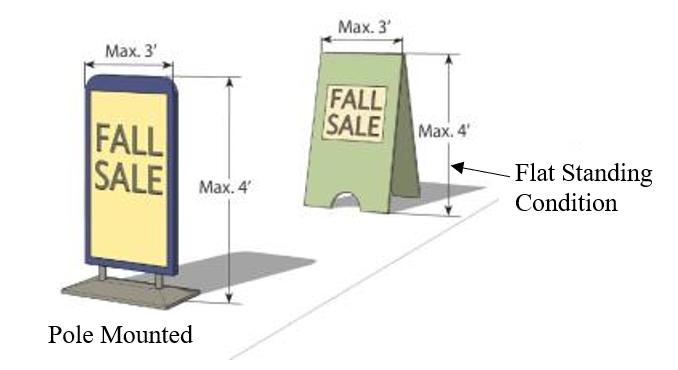
C. Size and Height. Sandwich board signs: maximum of four feet in height, maximum of three feet in width. (Note: sandwich board sign height is measured in the flat standing position, rather than in open standing position.) Pole-mounted signs: maximum of three square feet per side, four feet high.
D. Number. Not more than one portable sign may be displayed per business, per tenant space.
E. Location. Must be located no further than 10 feet from the primary building of the business, or, if there is only one business or tenant space on the site, it may be located not farther than then 10 feet from the site’s driveway entrance. No portable sign may be located on the city right-of-way (which includes the sidewalk), without a street right-of-way use permit.
F. Display Hours. Portable signs, including temporary portable signs, may be displayed during business or operating hours only. (Ord. 1965 § 2, 2017).
20.84.230 Projecting signs.
No permit shall issue for any projecting sign which does not comply with the following standards:
A. Number. One projecting sign may be allowed per tenant space or building frontage. Projecting signs are permitted in addition to allowable wall signage.
B. Sign Size.
1. Nonresidential Zones. The face of a projecting sign shall not exceed 12 square feet in area.
2. Residential Zones. The face of a projecting sign shall not exceed 1.5 square feet in area.
Projecting Sign(2).152122.png)
C. Location.
1. No part of any projecting sign shall be located lower than eight feet above the grade of sidewalk, walkway or driveway which is directly below the sign, or within three feet of the sign.
2. Projecting signs may extend a maximum of four feet from the building and shall be hung a minimum of six inches away from the building.
3. No projecting sign shall be located within 25 feet of another projecting sign on the same site or on the same building.
4. No projecting sign shall be located higher than the first story level of the building.
5. No projecting sign shall extend into the right-of-way, including the sidewalk, without an approved right-of-way use permit under Chapter 13.12 PMC.
D. Design.
1. Nonresidential zones: may be illuminated, internally or indirectly. In residential zones, projecting signs may not be illuminated.
2. Projecting signs shall be perpendicular to the building wall to which they are affixed.
3. Projecting signs shall not exceed four inches in thickness.
4. Projecting signs shall be supported by or suspended from solid rods or otherwise tethered or reinforced to avoid movement in wind.
E. Zone. Residential and nonresidential zones: as limited above. (Ord. 1965 § 2, 2017).
20.84.240 Service island signs.
No permit shall issue for a service island sign which does not comply with the following standards:
A. Number and Size.
1. Island Canopies. One sign on the canopy fascia per street frontage, not to exceed 20 percent of the area of canopy fascia to which the sign is mounted.
2. Spandrel Signs and Canopy Support Signs. Spandrel signs shall not exceed 20 percent of the spandrel area, and both spandrel signs and signs attached to canopy support columns shall be deducted from allowable wall signage on the associated principal building on the site.
B. Zone. Not allowed in residential zones.
C. Design. Spandrel signs may be internally illuminated, subject to the illumination standards of PMC 20.84.090. Signs attached to canopy support columns shall not be illuminated. (Ord. 1965 § 2, 2017).
20.84.250 Sign walkers.
Sign walkers are allowed, subject to the following standards:
A. Permit. A permit is not required for a sign walker, but the sign walker shall comply with all the applicable requirements of this chapter.
B. Number. No limit.
C. Area. The sign walker’s sign shall not exceed eight square feet in area, and shall not exceed eight feet in height when held in place.
D. Zone. Allowed in nonresidential zones only.
E. Design. The sign walker’s sign cannot be illuminated. Sign walkers shall be limited to daylight hours only. A sign walker’s sign may not include any element of a prohibited sign as described in PMC 20.84.040.
F. Location. Sign walkers are restricted to a minimum of 30 feet from a street or driveway intersection, measured from the back of the curb or edge of pavement if no curb exists, and shall not be located in any of the following places:
1. On any public property or within public right-of-way, although sign walkers are allowed on public sidewalks;
2. In parking aisles or stalls;
3. In driving lanes;
4. On fences, walls, boulders, planters, other signs, vehicles, utility facilities or other structures; or
5. In a manner which results in a sign walker physically interfering with motorists, pedestrians or bicyclists. (Ord. 1965 § 2, 2017).
20.84.260 Temporary signs.
A. No Permit Required. No sign permit is required for temporary signs.
B. Removal. Temporary signs shall be removed if the sign is in need of repair, is worn, dilapidated or creates a public nuisance.
C. Materials. See PMC 20.84.100 (Sign materials) and the definition of “temporary sign” in PMC 20.84.290.
D. City Property (Excluding City Right-of-Way). Temporary signs on city-owned property (excluding city right-of-way) are allowed only in conjunction with an approved special event permit. No sign may be placed in the roadway.
E. City Right-of-Way Outside of the Roadway. Temporary signs on city right-of-way placed outside of the roadway must comply with the following requirements:
1. Location. Allowed only between the property line and the back of the nearest curb, or where no curb exists, between the property line and the nearest edge of the pavement. Signs may not be placed on sidewalks, driveways or other paved areas designed for pedestrian or vehicular use, or as conditioned in a right-of-way use permit.
2. Approval of Abutting Owner. Approval of the abutting owner is recommended.
3. Type. Signs on stakes that can be manually pushed or hammered into the ground are allowed. All other signs are prohibited, unless specifically allowed by a right-of-way use permit.
4. Size and Height. Limited to four square feet, and three feet in height.
5. Dilapidated or Nuisance Signs. Any temporary sign in the right-of-way that is dilapidated or a nuisance shall be removed by the person responsible for placement of the sign.
6. Other Signs. The city may allow other signs in city right-of-way with a right-of-way use permit.
F. Residential Zones. Temporary signs may be placed on property residentially zoned in accordance with the requirements of this section and the following:
1. Window Signs. Limited to no more than one temporary window sign per residential unit, not to exceed four square feet.
2. Freestanding Signs (Includes Post-Mounted, Stake and Portable Signs).
a. Single-Family Zones. Temporary freestanding signs shall not exceed four square feet in size and five feet in height, if the sign is mounted on the ground, and not to exceed three feet in height if the sign is stake-mounted or portable.
b. Multifamily Zones. Temporary freestanding signs shall not exceed six square feet in size and five feet in height if the sign is post-mounted on the ground, and not to exceed three feet in height if the sign is stake-mounted or portable.
3. Surface-Mounted Signs. Limited to sites two acres or larger:
a. Size. No larger than 32 square feet.
b. Location. Must be flatly affixed to walls below the fascia or parapet line, or flatly affixed to on-site fences either facing or abutting the street, or facing inward to the subject site. Signs shall not be attached or tethered to other site improvements.
G. Nonresidential Zones. Temporary signs are allowed on nonresidentially zoned property in accordance with the requirements of this section and the following:
1. Window Signs. Limited to 25 percent of the window area, subject to the window sign requirements of PMC 20.84.270.
2. Freestanding Signs (Including Post-Mounted, Stake and Portable Signs). Size/height: limited to four square feet and five feet in height if the temporary sign is mounted in the ground, and not to exceed three feet in height if the temporary sign is portable.
3. Surface-Mounted Signs.
a. Size. Limited to 30 square feet.
b. Location. Must be flatly affixed to walls below the fascia or parapet line, or flatly affixed to on-site fences either facing the abutting street, or facing inward to the subject site. Signs shall not be attached or tethered to other site improvements.
H. Temporary Signs on Large Properties, Residential or Nonresidentially Zoned Properties. The following temporary signs may be placed on any site at least two acres in size, in accordance with the requirements of this section and the following:
1. Type. Any type.
2. Size/Height. Not to exceed 64 square feet and up to eight feet above ground level.
3. Exclusivity. The sign allowed under this subsection is in lieu of and shall not be displayed with or be in addition to other temporary signs allowed by this section. (Ord. 1965 § 2, 2017).
20.84.270 Window signs.
No permit shall issue for a permanent window sign which does not comply with the following standards:
A. Number. No more than one permanent window sign may be placed in a single window.
Figure 20.84.270A
Window Sign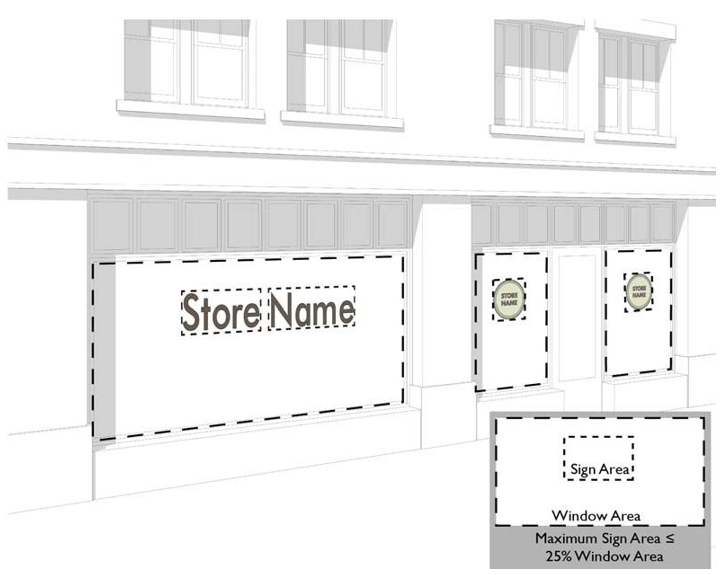
B. Window Coverage. Window signs (temporary and permanent) shall not exceed 25 percent of the area of the window on which they are displayed.
C. Location. No higher than second story windows for permanent window signs. (For the requirements applicable to temporary window signs, see PMC 20.84.260.)
D. Zone. Allowed in all zones.
E. Design. Permanent window signs are limited to individual painted or vinyl cut-out letters and graphics, or neon signs constructed with or without a solid or opaque background. Permanent signs with solid backgrounds are not permitted in windows in order to ensure maximum light and visibility through windows. Temporary window signs are exempt from the restrictions in this subsection. (Ord. 1965 § 2, 2017).
Article V. Definitions, Chart of Sign Types
20.84.290 Definitions.
The words and phrases used in this chapter shall be construed as defined in this section, unless the context clearly appears otherwise. Unless specifically defined in this section, the definitions set forth in other provisions of this code shall likewise apply to this chapter.
“A”
“Abandoned sign” means a sign, the face of which has been removed or is broken and is not refaced within 180 days thereafter. Abandoned signs shall also include signs with rusted, faded, peeled, cracked or otherwise deteriorated materials or finishes that have not been repaired within 90 days after the city provides notice of the sign’s deteriorated condition under the city’s code enforcement chapter (Chapter 20.82 PMC).
“Accessory sign” means a permanent, freestanding sign of limited height and size that provides supplemental opportunity for freestanding signage on a site.
“Aerial sign” means a free floating balloon, kite or similar object not directly secured to property within the city.
A-Frame Sign. See also “portable sign” or “sandwich board sign”; means signs capable of standing without support or attachment.
“Alter” means to change the copy, color, size, shape, illumination, position, location, construction or supporting structure of a sign, not including ordinary maintenance.
“Area, sign” means the smallest square, rectangle, parallelogram or circle that will enclose the extreme limits of writing, representation, logo, or any figure of similar character, together with any frame, background area, structural trim, or other materials or color forming an integral part of the display or used to differentiate such sign from the background against which it is placed. The supports or uprights on which any such sign is supported shall not be included in determining the sign area. The area of signs with two faces shall be considered to be the area of the largest face. The area of signs with three or more faces shall be considered to be the area of the largest face or one-half the area of all of the faces, whichever is less (see PMC 20.84.120).
“Awning or canopy sign” means a sign affixed to or imprinted on a temporary shelter or a permanent architectural projection, such as an awning or canopy, composed of nonrigid materials on a supporting framework, affixed to the exterior wall of a building, extending over a door, entrance, window or outdoor service area.
“B”
“Business activity” means an enterprise offering goods, services, or other consideration to the public, in legal occupancy of a site or of a specific portion of a site and under separate and distinct management from any other enterprise located on the same site.
“Business frontage” means the horizontal dimensions of a building or individual business elevation measured at ground level.
“C”
Canopy or Awning Sign. See definition under “awning or canopy sign.”
“Changeable copy sign” means a sign or portion thereof which is designed to have its message or copy readily changed manually or by remote or automatic means without altering or replacing the face or surface. Changeable copy signs support hardcopy text or graphics and do not use digital or electronic text or images.
“D”
“Digital sign” means a changeable copy sign with monochrome LED (light emitting diodes) text, graphics or symbols over a black, nonilluminated background.
“Directional sign” means a sign erected for the purpose of facilitating or controlling the efficient and safe movement of pedestrians or vehicles within a multitenant development.
“E”
“Electronic message center sign” means an electrically activated changeable copy sign having variable message and/or graphic presentation capability that can be electronically programmed by computer or handheld device from a remote location. EMCs typically use light emitting diodes (LEDs) or liquid crystal display (LCD) as a lighting source.
“Elevation” means the visible vertical plane of the side of a building from ground level to the roofline.
“Elevation, primary” means the side of a building directly abutting either a street or a parking area. A business owner may choose which elevation is considered the primary elevation, except that in a multi-tenant building, the elevation which is contiguous to other businesses shall be the primary elevation.
“Elevation, secondary” means any elevation of a building not determined to be a primary elevation.
“F”
“Facade” means the elevation of a building extending from the ground level up to the bottom of the fascia on a pitched roof building, and up to the top of the wall or parapet on a flat roof building. The area of a facade for purposes of calculating allowable wall signage includes the area of the windows and doors but excludes openings that do not have solid coverings, such as breezeways, colonnades and gateways that extend to the backside of the building.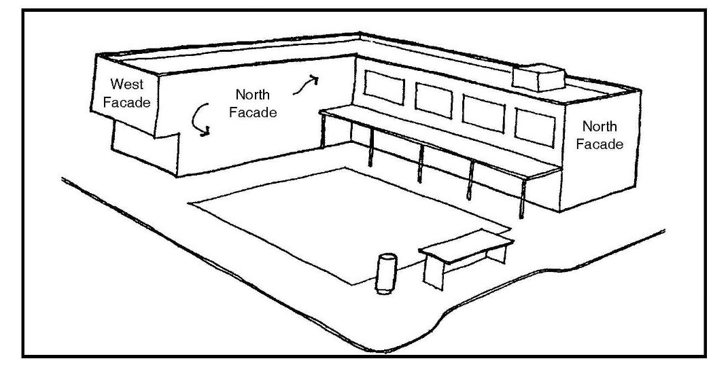
“Fascia” means an architectural term for a vertical frieze or board under a roof edge or which forms the outer surface of a cornice, visible to an observer.
“Festoon” means materials or devices, whether or not they contain printed material, which are attached to real or personal property with the purpose or effect of attracting public attention to an object or site. Festoons include flags, pennants, balloons, ribbon, tinsel and other similar materials, regardless of size.
|
|
“Flag” means a flat piece of cloth with distinctive colors, patterns or symbols, having one end of the cloth attached to a vertical staff (directly or by rope and pulley mechanism) and all other ends free-flowing under natural movement of wind.
“Flag canopy” means a line of flags, or a series of lines of flags, suspended above a site.
“Flashing sign” means an electric sign or portion thereof, except electronic message center signs, which changes light intensity in a sudden transitory burst, or which switches on and off in a constant pattern in which more than one-third of the nonconstant light source is off at any one time.
“Foot-candle” means a unit of illumination equal to that given by a source of one candela at a distance of one foot (equivalent to one lumen per square foot or 10.764 lux).
“Freestanding sign” means a sign and its support pole or base standing directly on the ground that is independent from any building or other structure.
“Freeway” means a limited access highway, state route or interstate.
“Freeway oriented sign” means a sign within 150 feet of a freeway right-of-way that has its sign face parallel to, perpendicular to, angled toward, or otherwise readable from the freeway right-of-way.
“Frontage” means the ground floor horizontal distance of a building or portion thereof occupied by the subject tenant. Building frontage shall only be measured along a ground floor wall which has a customer entrance that faces and has access onto a public open space, such as a courtyard or plaza, or is adjacent to a public street, or adjacent to a driveway or parking lot which serves that use. If any building frontage does not consist of one straight line, the frontage of any offset portion shall be projected, for computation purposes, to the extension of the line of the most forward face of the building.
“G”
“Gross leasable space” means area of a single leasable space, regardless of the number of tenants or leases within the space.
“H”
“Halo illuminate” means a light source placed behind totally opaque letters or symbols so that the light reflects off the wall or background to which the letters or symbols are mounted rather than emanating through the letters or symbols, creating a halo effect that leaves the letters or symbols viewable in silhouette form only.
“Height of sign” means the overall height of the sign above grade directly below or at the base of the sign.
“I”
“Illegal sign” means a sign which does not conform to the requirements and standards of this chapter and which does not meet the criteria of a nonconforming sign as defined in this section.
“Integrated development site” means any commercial or noncommercial development site, regardless of the number of lots or individual tenants, that is developed with common parking, layout, architecture or design features.
“Item of information” means a word, figure, logo, abbreviation or other symbolic representation.
“L”
“Logo” means a design of letters, colors or symbols used as a trademark or for identification in lieu of, or in conjunction with, other signs.
“Logo shield” means a logo contained within an area no greater than four square feet, incorporated into a larger sign face or designed as an individual sign or component of a sign containing individually mounted sign graphics.
“Lot line” means a line that separates two lots.
“Luminance” means the photometric quality most closely associated with the perception of brightness. Luminance is measured in candelas per square meters or “nits.”
“M”
“Mansard” means a roof with two slopes on each side of the four sides, the lower steeper than the upper.
“Master sign plan” means a coordinated sign plan which includes the details of all signs (not including exempt or temporary signs) which are or will be placed on a site.
“Monument sign” means a freestanding low profile sign with the sign width greater than the sign height and designed with a solid base and background.
“Motion” means the depiction of movement or change of position of text, images or graphics. “Motion” shall include, but not be limited to, visual effects such as dissolving and fading text and images, running sequential text, graphic bursts, lighting that resembles zooming, twinkling or sparkling, changes in light or color, transitory bursts of light intensity, moving patterns or bands of light, expanding or contracting shapes and similar actions.
“Multiple building complex” means a group of structures housing more than one type of retail business, office or commercial venture, and generally under one ownership and control.
“N”
“Natural grade” means the topographic condition or elevation of a site or portion of a site over the past five years, or the finished grade of an approved site development plan. Changes to grade or elevation resulting from fill, mounding or berming within five years preceding any requested permit other than a site development plan shall not be considered natural grade for permitting purposes.
“Neon sign” means a sign with illumination affected by a light source consisting of a neon or other gas tube which is bent to form letters, symbols or other shapes.
“Nighttime hours” means from one-half hour before sunset to one-half hour after sunrise.
“Nonconforming sign” means any sign, which at one time conformed to all applicable requirements and standards of this chapter, including all permit requirements, but which subsequently ceased to so conform due to changes in such requirements and standards.
“Nonresidential zone” means, in the context of this chapter, any zone that does not include residential dwelling units except for mixed-use zoning districts where residential units are located above or behind nonresidential uses and the ground floor streetscape is characterized by commercial and other nonresidential uses.
“O”
“Opaque” means a material that does not transmit light from an internal illumination source.
“P”
“Painted sign” means a sign painted directly on a building or on material which is then attached to a building. See also “wall sign.”
“Pan-channel” means a sign graphic that is constructed of a three-sided metal channel, usually having a light source contained within the channel. The open side may face inward, resulting in silhouette lighting, or it may face outward to allow full illumination. The open side of the channel may be enclosed with a translucent material.
“Parapet” means a protective wall or barrier projecting above any canopy, balcony or roof.
“Permanent sign” means a sign constructed of weather resistant material and intended for permanent use and that does not otherwise meet the definition of “temporary sign.” Wall-mounted sign holders designed for insertion of signs and posters shall be considered permanent signage and subject to all standards of this chapter.
“Pole sign” means a sign mounted on a weighted base, intended to be movable.
“Portable sign” means a freestanding sign that is readily movable and not permanently affixed to the ground, including A-frame or sandwich board signs, pole signs mounted on weighted bases, and similar signs that are used on more than a temporary basis.
“Projecting sign or projection sign” means a sign attached to a building with the face not parallel to the vertical surface of the building. Projecting signs include signs projecting directly from walls, or signs hanging from porch ceilings or other support structures.
“R”
“Raceway” means a box-type conduit to house electrical wires for signs and used to support and/or affix signage on a wall.
“Right-of-way” is the strip of land platted, dedicated, condemned, established by prescription or otherwise legally established for the use of pedestrians, vehicles or utilities.
“Roadway” means that portion of the street improved, designed, or ordinarily used for vehicular travel and parking, exclusive of the sidewalks and shoulder. Where there are curbs, the roadway is the curb-to-curb width of the street.
“Roofline” means the uppermost edge of the roof or the top of the parapet excluding mechanical equipment screens, whichever is highest. Where a building has several roof levels, the roofline shall be the one belonging to that portion of the building on which the sign is located.
“Roof-mounted sign” means a sign which has a point of attachment to the roof or mansard of a building. Architectural projections, including mechanical equipment screens, above any parapet or roofline whose sole function is a background for signs shall be considered a sign structure. A sign on such an architectural projection shall be considered a roof sign.
“S”
Sandwich Board Sign. See “A-frame sign” definition.
“Service island sign” means a permanent sign displayed on the service island of a gas station.
Setback. For monument and freestanding signs, the “setback” from any property line shall be the outside edge of the sign closest to the property line (see Figure 20.84.290B).
Figure 20.84.290B
Setback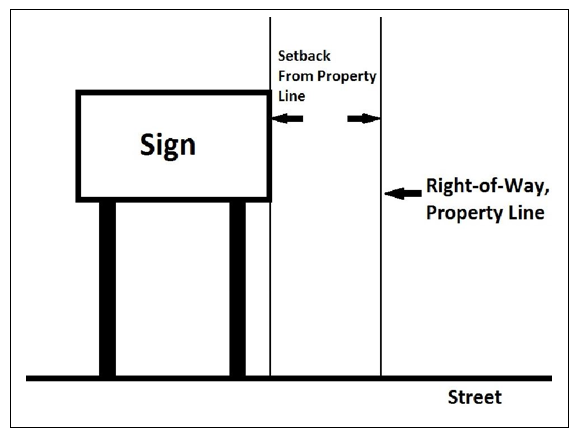
“Sign” means letters, figures, symbols, trademarks, or logos, with or without illumination, intended to identify any place, subject, person, firm, business, product, article, merchandise or point-of-sale. A sign also includes balloons attached to sign structures, products, streamers, spinners, pennants, flags, inflatables, festoons or similar devices intended to attract attention to a site or business, as well as architectural or structural forms, illuminated panels, spandrels, awnings and other structural or architectural features not common to classic vernacular or noncorporate regional architecture and that are intended to convey a brand, message or otherwise advertise a location or product, whether or not such features include text or graphics and whether or not they serve other practical purposes such as lighting, covering or enclosure of persons or products. A sign includes any device which streams, televises or otherwise conveys electronic visual messages, pictures, videos or images, with or without sound or odors. Refer to PMC 20.84.040 for a list of prohibited signs.
“Sign walker” means a sign carried by a person.
“Signable area” means the area of the largest rectangular portion of a face of a building to which a sign is affixed or proposed to be affixed, which can be included within parallel, vertical and horizontal lines uninterrupted by significant architectural features of the building.
“Site” means a unit of land, together with all improvements thereon, determined as follows:
1. A unit of land which may be conveyed separately from any and all adjacent land without the requirement of approval of a boundary line adjustment, short plat or a preliminary plat.
2. Two or more buildings or business activities that are or will be related to each other physically or architecturally, such as by sharing off-street parking facilities, so as to form an integrated development, such as a shopping center, industrial park, or office complex.
“Spandrel” means a panel or box-type structure that spans between and/or is connected to the support columns of a porch, colonnade or canopy, usually for architectural embellishment and/or signage purposes.
“Special event sign or temporary sign” means signs or advertising displays or a combination thereof which advertises or attracts public attention to a special one-time event, including, but not limited to, the opening of a building or business activity, the sale of goods and services at discounted or otherwise especially advantageous prices or similar event.
“Static” means without motion.
“Story” means that portion of a building included between the upper surface of a floor and the upper surface of the floor or ceiling next above.
“Suspended sign” means a sign mounted above a sidewalk adjacent to a business, affixed to a beam, overhang, roof or other fixture that is an integral part of a building.
“T”
“Temporary sign” (which may include “temporary use sign”) means any sign that is used temporarily and is not permanently mounted, painted or otherwise affixed, excluding portable signs as defined by this chapter, including any poster, banner, placard, stake sign or sign not placed in the ground with concrete or other means to provide permanent support, stability and rot prevention. Temporary signs may only be made of nondurable materials including, but not limited to, paper, corrugated board, flexible, bendable or foldable plastics, foamcore board, vinyl canvas or vinyl mesh products of less than 20-ounce fabric, vinyl canvas and vinyl mesh products without polymeric plasticizers and signs painted or drawn with water-soluble paints or chalks. Signs made of any other materials shall be considered permanent and are subject to the permanent sign regulations of this chapter.
“Tenant space” means the entire building which encompasses a building or use on a site; or in buildings designed for multi-tenant occupancy, it is the space between demising walls and which has an independent entrance to common corridors or to the outside. Portions of tenant spaces that are sublet to or otherwise allowed to be used by persons or businesses other than the principal person or business of a tenant space are not considered tenant spaces in the context of this chapter.
“U”
“Unshielded lighting” means an external illumination source which is exposed to view.
“W”
“Wall sign” means a sign which is attached parallel to or painted on a wall, including parapet or canopy fascia, or a building.
“Width of sign” means the total horizontal dimension of a sign, including all frames or structures.
“Window” means the entire window unit including individual sashes or panes that might otherwise divide the area between the head, jamb and sill; except that in commercial storefront window assemblies, a single “window” is the glass area between each mullion that divides the window assembly, whether installed as a single piece of glass or as multiple pieces of glass divided by muntins.
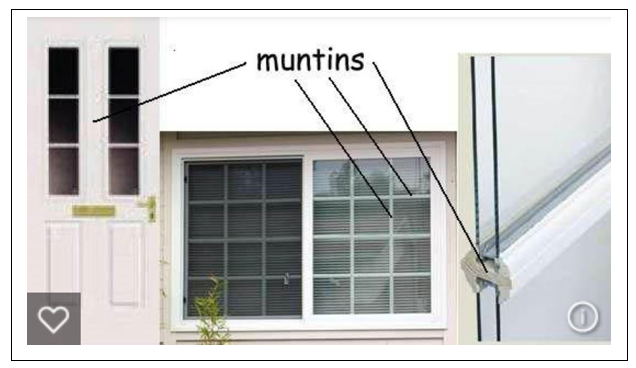 “Window sign” means a sign that is attached to or is intended to be seen in, on or through a window of a building and is visible from the exterior of the window. (Ord. 1965 § 2, 2017).
“Window sign” means a sign that is attached to or is intended to be seen in, on or through a window of a building and is visible from the exterior of the window. (Ord. 1965 § 2, 2017).



